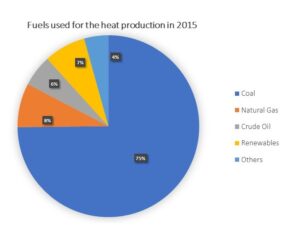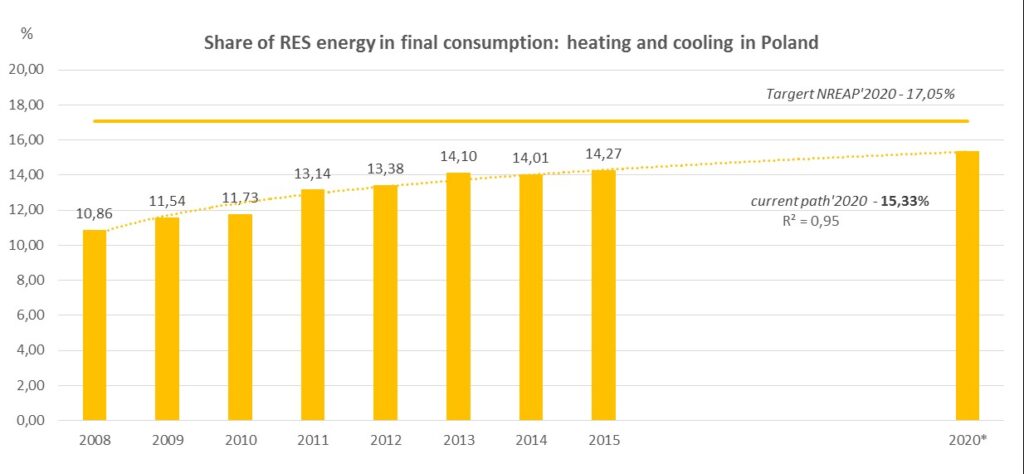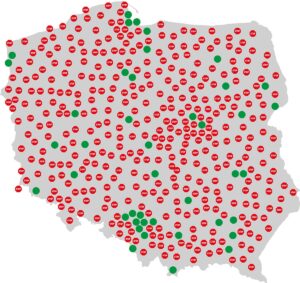Polish District Heating Sector – from coal to solar?
- News
- 11 May 2017
- by SDHp2m

The European Project SDHp2m is addressing the market uptake challenges to increase the share of Solar District Heating in Europe, and more specifically in Poland and other selected European regions. The IEO, the Polish Institute for Renewable Energy, is a member of the project consortium. Approximately only 7.4% of district heating in Poland is produced from renewable energy sources (RES), solar and geothermal energy have marginal shares and biomass is almost the exclusive renewable energy source, while 75% of the heat production is generated in the combustion process of coal.
The chart represents the structure of fuels used for heat production in Poland in 2015.
The Polish renewable heating sector is not growing according to the path foreseen in the Renewable Energy Directive (RED) 2009/28/EC and the green heat direction specified in Polish National Renewable Energy Action Plan (NREAP) up to 2020. According to IEO, Poland will not achieve the 2020 renewable energy target. In the case of the renewable heating and cooling sub-goal (17% in 2020), the target will be missed by approximately 1.5%.

One of the arguments which might push Polish district heating systems towards more efficient solutions is the definition of ‘efficient district heating and cooling’ included in the Energy Efficiency Directive (EED) 2012/27/EU Art.2 (41) that defines efficient district heating and cooling networks if they use ‘at least 50 % renewable energy, 50 % waste heat, 75 % cogenerated heat or 50 % of a combination of such energy and heat’. According to the Chamber of Commerce Polish District Heating, 85% of the existing district heating systems in Poland do not fulfil these requirements and need to be adjusted to European standards.

Regarding Polish national legislation, new regulative proposals has been introduced by the Ministry of Energy to promote and incentivise the purchase renewable energy sources for heating purposes. In Poland now, the interest of district heating companies for installing renewable district heating systems combined with heat storage is growing rapidly. An example of this phenomenon can be exemplified by the district heating company in Opole which in 2016 built solar supported district heating demonstration installation (260 m2 of solar collectors) connected to the district heating network.
In the current European conditions, district heating systems based on renewable energy sources are very advances from a technical point view and it allows the system to benefit from so called “economies of scale” by decreasing costs of heat production and eliminating the risk associated with future increasing fuel prices and environmental costs. It is also worth noticing that support EU programs e.g. – Operation Program for Infrastructure and Environment (managed by National Fund for Environmental Protection and Waste Management) that supporters the implementation and modernisation of district heating systems, including the switching to solar district heating.
The European Investment Bank conducts a program called ELENA, available in Poland, which can cover up to 90% of the preparation costs for large-scale plants. Technical support can be provided for both public and private entities, at local, regional and national levels. In the previous scheme, up to the year 2009, under this program already approximately 95 million EUR in terms of technical support was allocated for such kind of investment.
Moreover, given the current legal conditions in Poland, it is worth considering a storage of unbalances electricity power (which is significantly cheaper) coming from the wind energy (6 GW already installed in Poland). Entities involved in the heating sector with heat storage could use electricity from wind turbines and store and utilise heat in the most economically effective manner.
Apart from the investment subsidy schemes at the EU and national level, the key drivers for shifting from coal to solar in Poland seem to be EU environmental and climate protection regulation, as well as, the growing cost of high quality coal (the priority access to high quality coal was given to coal to power while district heating companies cannot effort to pay for high quality coal).
In conclusion, the implementation of district heating systems in Poland based on renewable energy sources (including storage) reflect that:
- The Polish government has a long-term direction for the development of the heating and cogeneration sector.
- The Polish government is setting up longer term priority in renewable energy and district heating policies.
- The price of solar heat is unlikely to increase since it is not attached to unpredictable fuel prices and costs of emission allowances.
- Solar collectors have a good reputation among public and private sector in Poland and are widely produced locally contributing to the development of the national market.
Information and data kindly provided by IEO, Institute for Renewable Energy.
Latest News
-

-
 26.10.2021 Celsius Summit 2021 – Energy Democracy
26.10.2021 Celsius Summit 2021 – Energy Democracy

